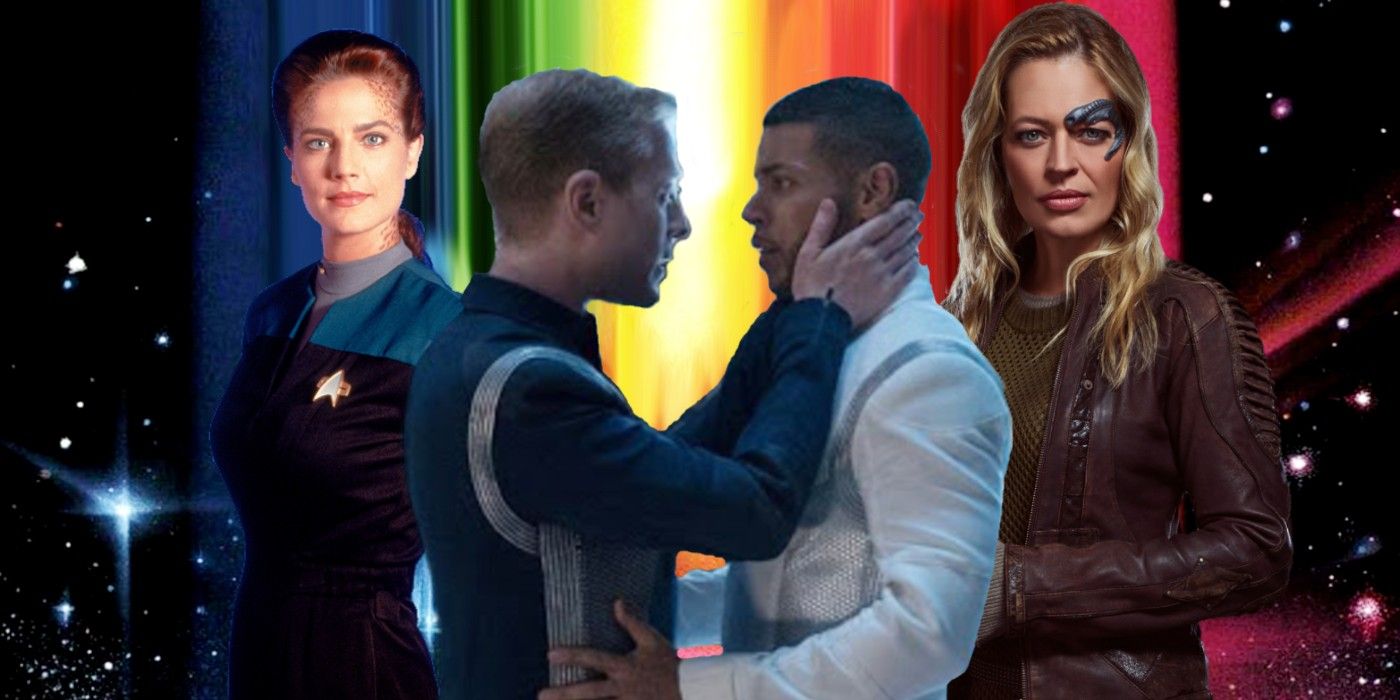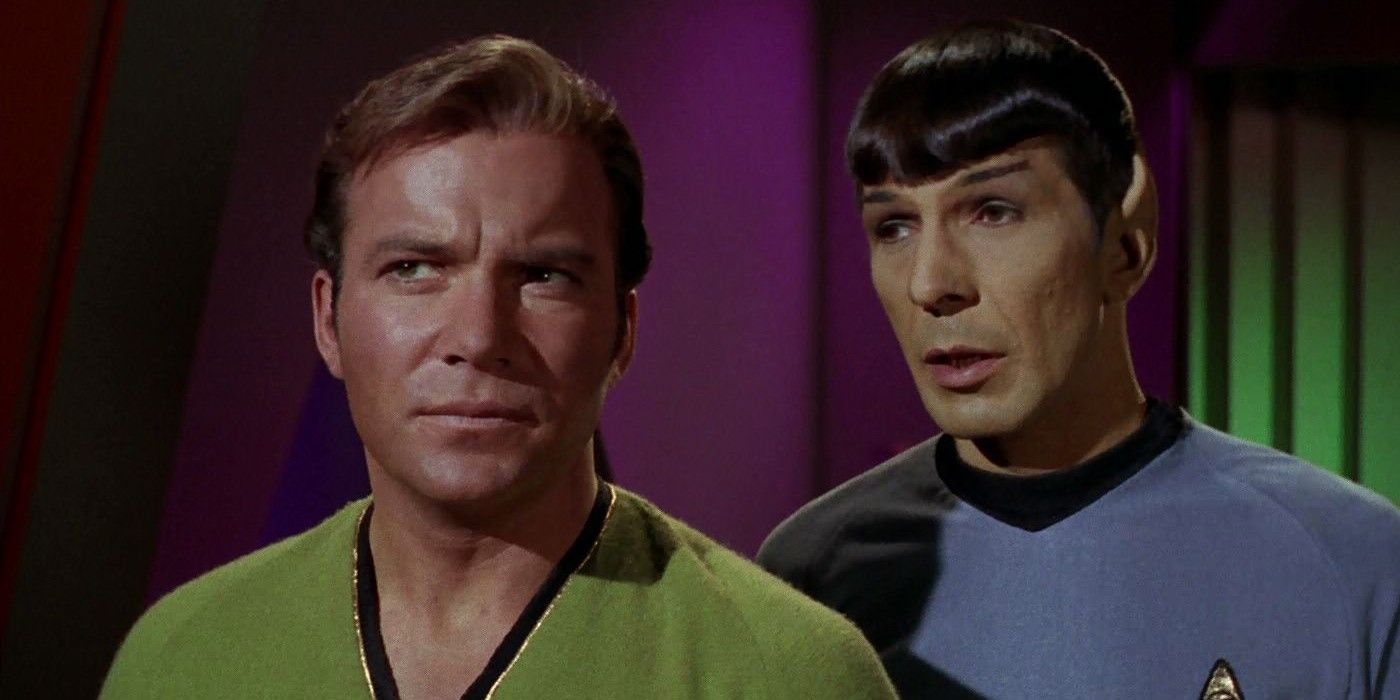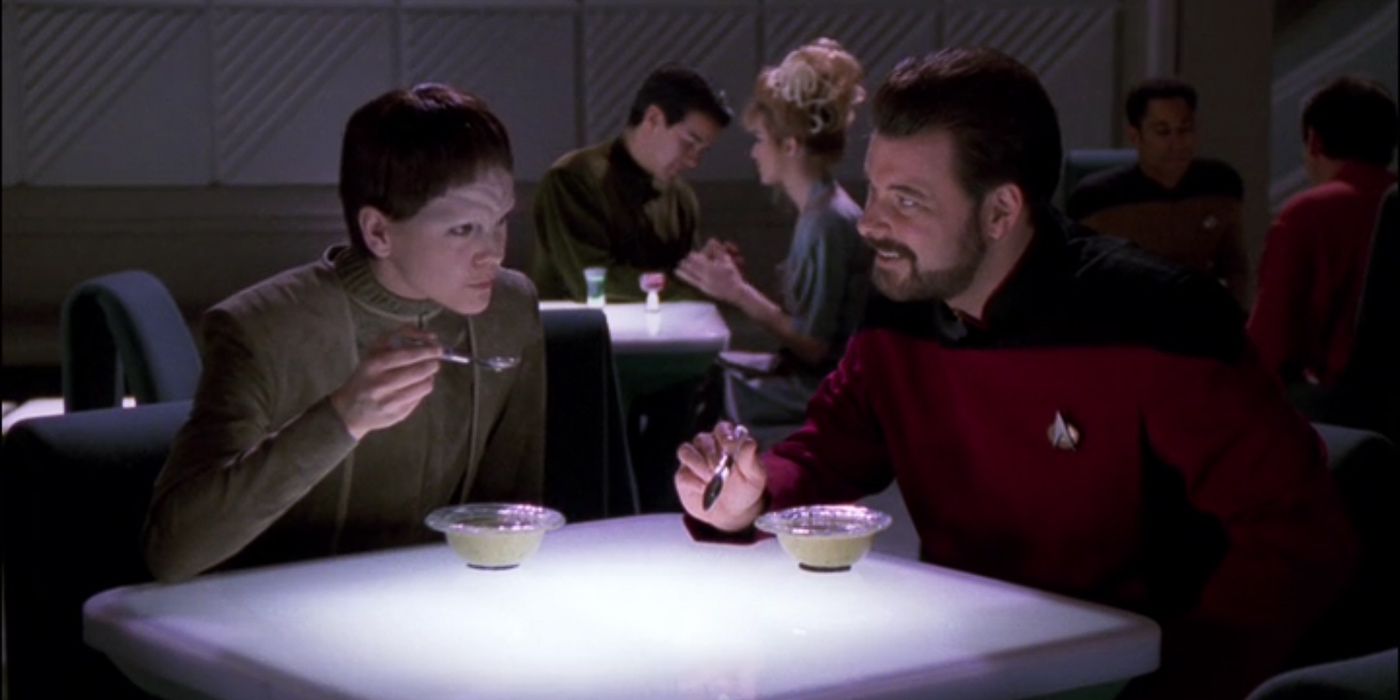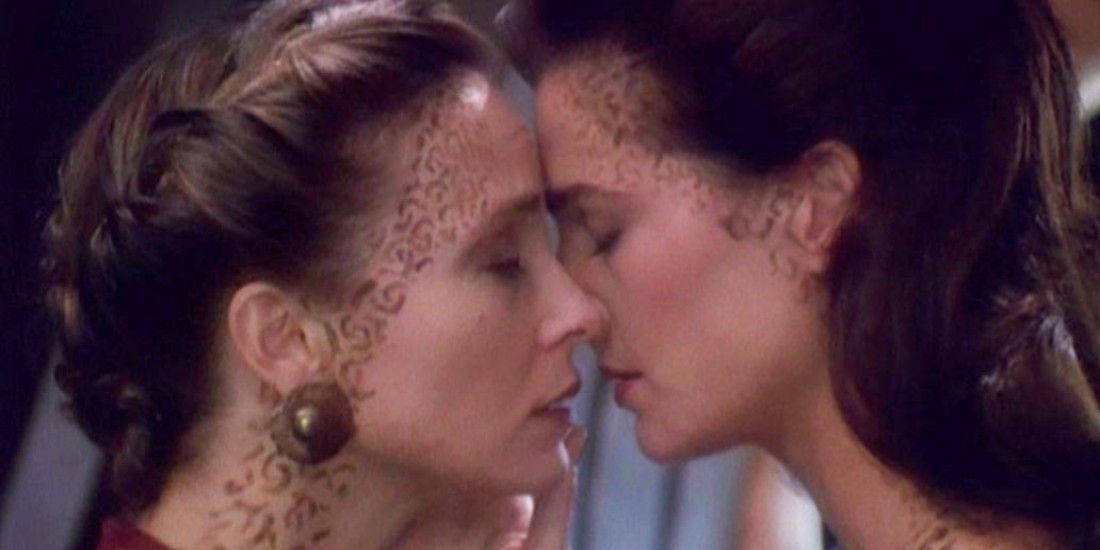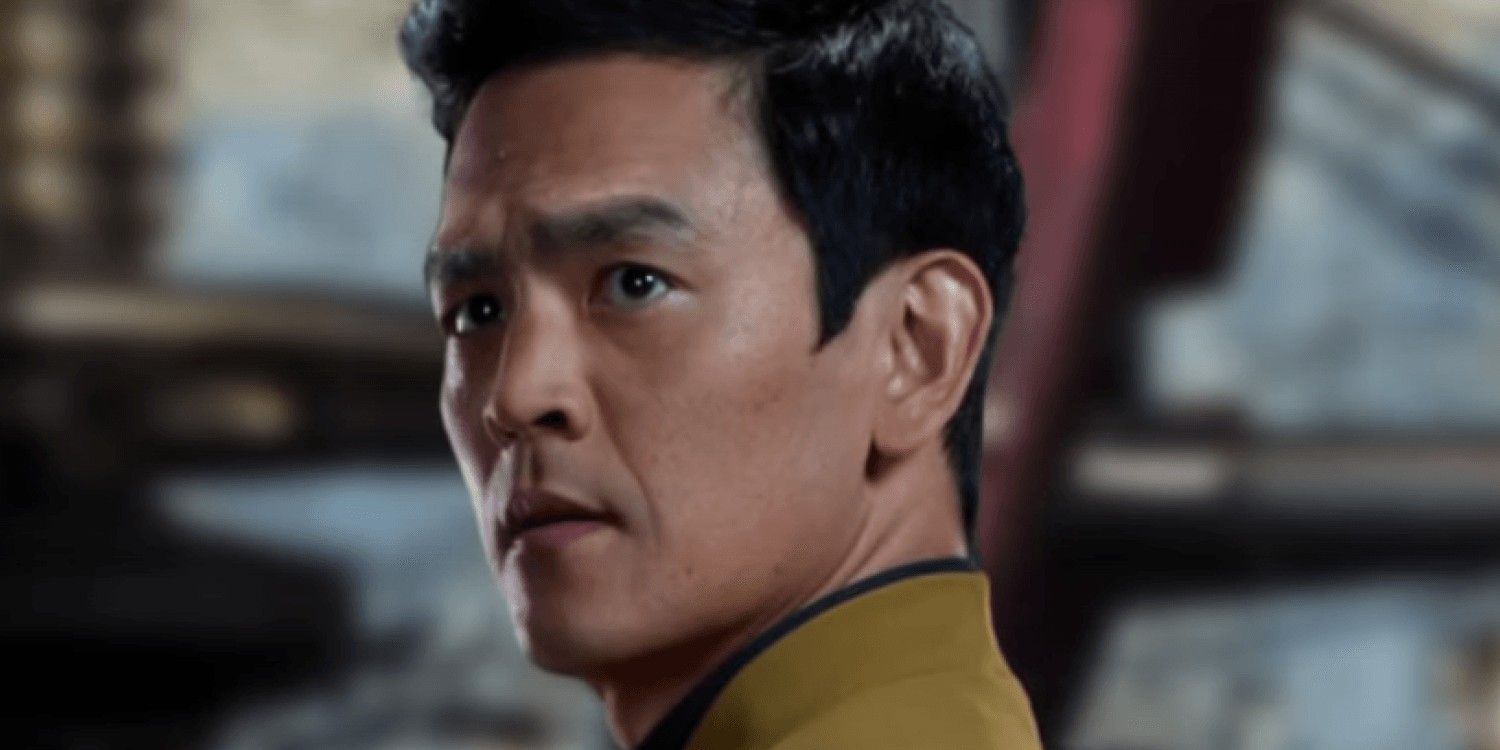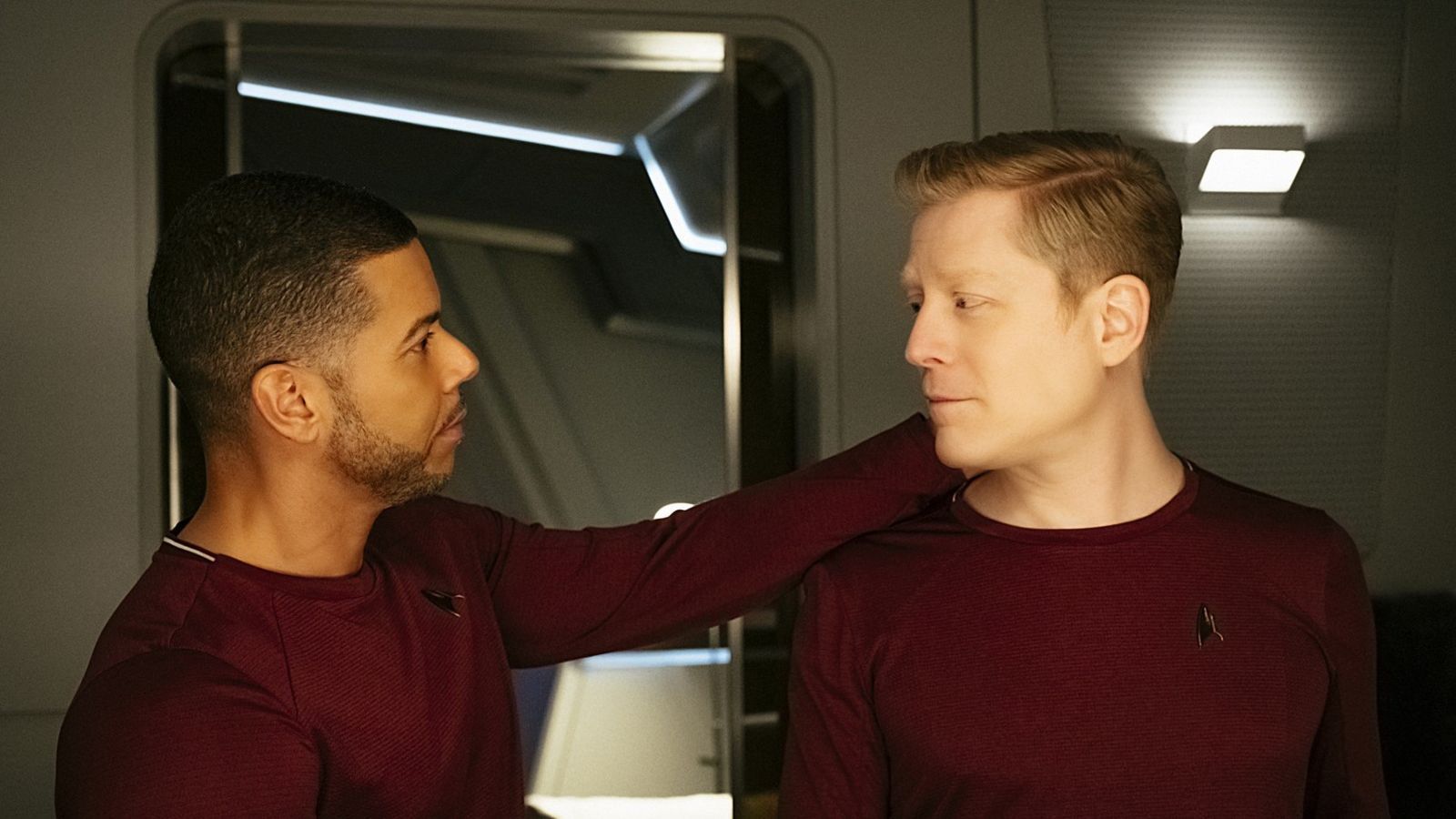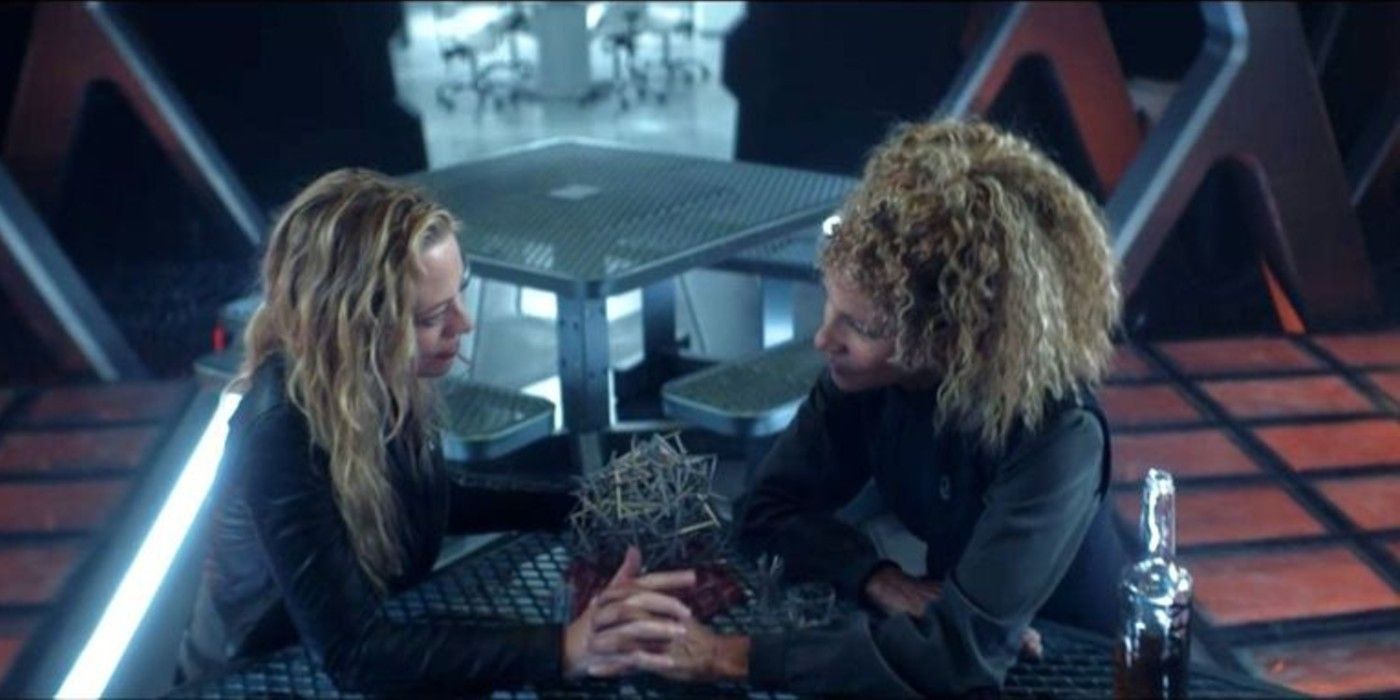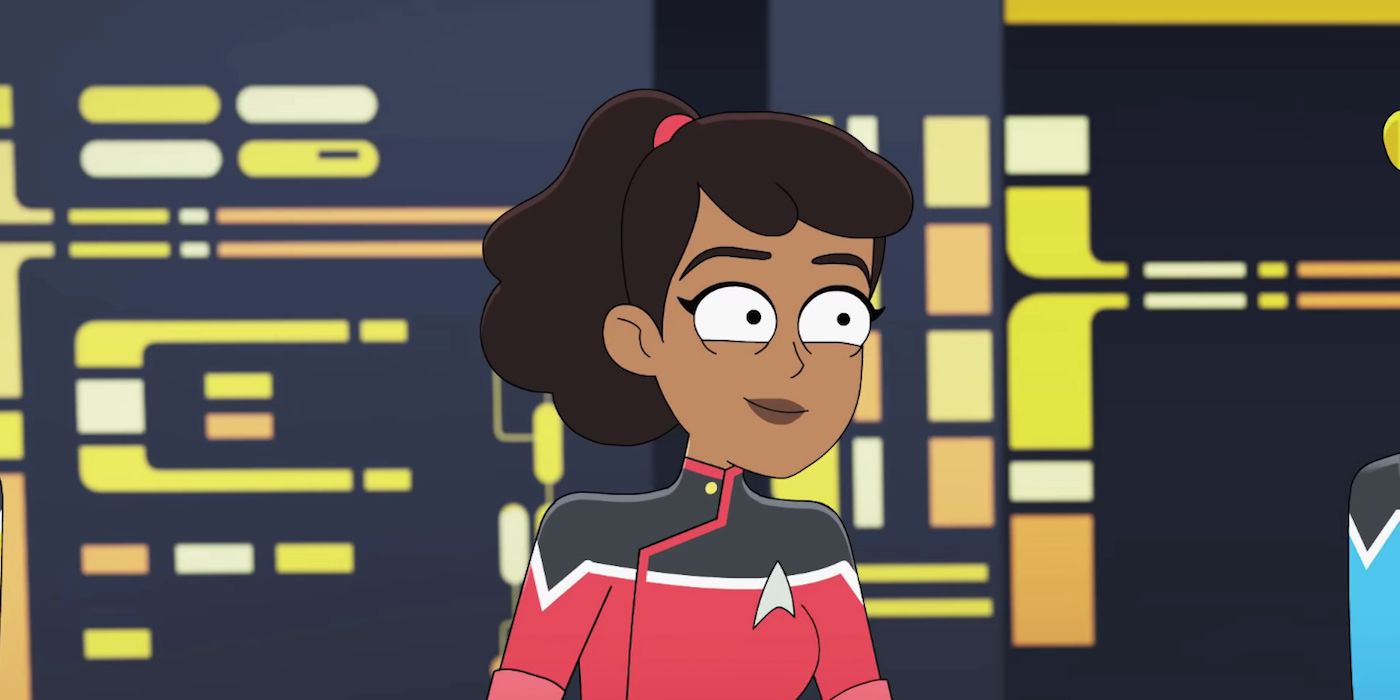The Star Trek franchise has always been known to push the boundaries of what is acceptable on mainstream television, and one of the ways it has done this is with explorations of LGBTQ+ themes. Star Trek: The Original Series kicked off the franchise in 1966, in a decade where a lot of social norms were in flux. The topics of race, gender, and sexuality were all being brought to the forefront of the public consciousness, and TOS began the tradition of using episodes to hold a mirror up to the social and political issues of the day. Following in the footsteps of TOS, every Star Trek captain and crew have since continued the trend of addressing pertinent real-world topics.
It is worth noting that, while TOS was a trendsetter in its storylines about race and gender politics, the show never had any explicit representation of queer characters, and neither did Star Trek: The Next Generation. During the time it was airing, there were a considerable number of established rules about what was and was not regarded as acceptable to show on network television. TOS got away with a lot that the network may have not wanted it to show, as did subsequent shows in the franchise, but it is only in the last four to five years that any explicitly LGBTQ+ characters have become part of the increasingly diverse Star Trek franchise.
This fact may seem like it refutes the idea that Star Trek has any kind of queer history. While explicit representation is very important, however, the Star Trek universe has historically not needed to be overtly queer in order to still be tied to the LGBTQ+ community. Whether through LGBTQ+ actors, the exploration of sociological and political themes, or by garnering the interest of queer fans who have felt a connection with certain characters, Stark Trek has a thread of queerness that can be followed throughout the majority of its shows and movies.
Star Trek: The Original Series
As stated previously, TOS did not feature any LGBTQ+ main characters, but George Takei, who portrayed Helmsman Hikaru Sulu, came out as gay in 2005, years after the end of the show's run. Since then, Takei has been a visible and active member of the LGBTQ+ community and champion of LGBTQ+ rights, for which he is known by even younger generations of sci-fi fans. Sulu was one of the main characters on TOS, and to know now that he was portrayed by a gay man who has always championed queer issues makes both Sulu and Takei very important figures in Star Trek's queer history.
Additionally, TOS saw the creation of a fan community that became drawn to two characters for what they perceived as the characters' queer subtext, namely Captain James T. Kirk and his First Officer Spock. The fandom that sprung up around Kirk and Spock is credited with the origins of "slash". Slash is when fans create fanworks such as writing or art that depict two male or two female characters from a specific piece of media in a same-sex relationship. The name slash comes from the backslash that is often added between the two characters' names to denote them as a couple (i.e. "Kirk/Spock"). Despite never being a couple on the show, Kirk and Spock were portrayed as one by fans in a number of fanzines that were passed around via mail during the 1970s, the precursor to current online fan communities. Whether the queer subtext between Kirk and Spock was intentional or not, the two characters are inextricably linked to the LGBTQ+ community for people who know their fandom history.
Star Trek: The Next Generation
Similar to TOS, Star Trek: The Next Generation, which ran from 1987 to 1994, had no explicitly LGBTQ+ main characters. One episode of the series, however, stands out as a compelling allegory for queer issues. Season 7 episode 17, titled "The Outcast", tells the story of the Enterprise crew encountering a group of aliens called the J'naii from a planet where binary gender does not exist. The J'naii all identify as gender-neutral, and anyone who harbors feelings of being either male or female is considered deviant and sick by society. During the course of the episode, Commander Riker works very closely with a J'naii named Soren, who reveals to him that she feels as though she is female. True to Riker's romancing skills, the two become close and begin a romantic relationship, but when they are discovered Soren is immediately put before a hearing to decide her fate, where she makes an impassioned plea for herself and people like her to be treated better by J'naii society. "It is not unnatural." She tells her people. "I am not sick because I feel this way. I do not need to be helped. I do not need to be cured."
Soren's speech during her hearing is a powerful and poignant message about the plight of those deemed different from the rest of society, and for those in the LGBTQ+ community watching this episode of The Next Generation when it first aired in 1992, her words must have hit home in some very meaningful ways. Sadly, they were not enough to save Soren from undergoing treatment that "cured" her inclinations towards femininity. A tragic end such as this one was the long-time norm for most queer characters on television and in movies, but despite this, the show still uses "The Outcast" to push the boundaries with regards to gender and sexuality, showcasing the plight of LGBTQ+ people during the early 1990s.
Star Trek: Deep Space Nine
Arguably, Star Trek: Deep Space Nine was the first show in the Star Trek franchise that had a main character who could be read as queer, in the form of Lieutenant Commander Jadzia (and later Ezri) Dax. Dax is a joined Trill, which means that she shares a body with a slug-like symbiont. While Trills have a lifespan similar to humans, the symbionts they coexist with are extremely long-lived and share multiple bodies across multiple lifetimes. More importantly, although Trills do have binary gender, the symbionts are not placed in exclusively male or exclusively female bodies, meaning that Dax has lived lives as both men and women.
Jadzia identifies as female, but the Trill as a race seem to have no issues with switching gender identity, or similarly, with same-sex relationships. "Rejoined", the sixth episode of Deep Space Nine season 4, shows Dax rekindling a relationship with Lenara Kahn, the wife of one of her past hosts. Although Dax used to be in a male body when she was married to Kahn, both are in female bodies when they reunite. Ultimately, the two women are barred from resurrecting their relationship by a different taboo in Trill society, one that prevents joined Trill from "reassociating" with past lovers lest they be ostracised. This taboo can be read as another allegory for the real-life discrimination LGBTQ+ couples face, but the show does not treat the fact that Jadzia and Lenara are women as a big deal. "Rejoined" was the first Star Trek show to depict a same-sex kiss, a big step forward for representation in the franchise.
Additionally, like TOS, Deep Space Nine is another example of a show where fans took an interest in two same-sex characters because of their queer subtext. The characters of Doctor Julian Bashir and Elim Garak, a Cardassian tailor were the subject of much speculation by the fandom, and interest in them as a couple remains high to the day. This interest, unlike what sprung up around Kirk and Spock, was also somewhat supported by both actors and the writers during the show's run. Andrew Robinson has said he deliberately played Garak as attracted to Bashir, and some of the creative heads including producer Ira Steven Behr expressed interest in exploring the idea of a romance further, although the idea ultimately never came to fruition.
The Reboot Films
The reboot films are the next stop on Star Trek's queer timeline, mostly because Star Trek: Voyager and Star Trek: Enterprise were largely devoid of queer themes. The reboot, however, picks up the thread in 2009, following alternate timeline versions of Kirk, Spock, and the rest of the TOS Enterprise crew. Similar to the show that inspired them, the films feature an openly gay actor as part of the main cast: Zachary Quinto, who was cast in the role of Spock in Star Trek (2009). Quinto has also been publicly out as gay since 2011 and is a strong advocate for LGBTQ+ rights and issues, much like George Takei.
Besides having a queer actor, the reboot films are arguably the first time an explicitly queer character becomes part of the Star Trek franchise. As a nod towards Takei, the creative team behind the third film, Star Trek: Beyond, chose to have their version of Sulu be in a same-sex relationship. The relationship is revealed at the beginning of Beyond, in a small scene that garnered both praise and criticism from fans. Some felt that the scene was too brief, and did not depict enough of the relationship to be called representation. George Takei even agreed with this, saying that while he appreciated being honored in this way, making Sulu gay betrayed Gene Roddenberry's original vision for the character. Despite this, Sulu and his family did mark another step in the right direction.
Star Trek: Discovery
Star Trek: Discovery is one of the most recent additions to the franchise, and also the show that has the most LGBTQ+ representation to-date. Star Trek: Discovery, premiered in 2017, has a total of five explicitly queer characters as part of the main cast. Engineer Paul Stamets and ships Doctor Hugh Culber were introduced as Star Trek's gay couple in the first season, and actors Anthony Rapp and Wilson Cruz, both part of the LGBTQ+ community themselves, have garnered praise for their portrayals of the characters. Meanwhile, the character of Jett Reno joined the crew in season 2, played by openly gay stand-up-comedian Tig Notaro. Discovery also boasts two newer queer characters as part of the cast in season 3; Adira and Gray are non-binary and transgender respectively and are played by actors who share their characters' gender identities.
This massive influx of queer characters is jarring when looked at against previous representation in the franchise, but it is also indicative of the time in which Discovery was created. During the twelve-year gap between the end of Star Trek: Enterprise and the beginning of Discovery, the amount of LGBTQ+ representation on television skyrocketed. Where other shows in the franchise existed in an age that was still reluctant to depict queer themes on-screen, Discovery has no such qualms by virtue of airing in the 2010s. This has allowed the show to fulfill the full promise of one of Star Trek's best-known mottos: infinite diversity in infinite combinations.
This can be best observed in Adira and Gray's story arc in Star Trek: Discovery season 4. Back in season 3, Gray gets killed during an attack on the ship, and Adira volunteers to join with Gray's Trill symbiont Tal, causing Adira to gain the memories of not just Gray, but every previous Trill host to Tal. After Adira and Tal are properly joined, Adira Tal continues to talk to Gray as an entity that only they can see. In Star Trek: Discovery season 4, Dr. Hugh Culber uses the technology that created Jean-Luc Picard's synthetic body to give Gray's consciousness his own body, allowing Adira Tal and Gray to reunite in the physical world. Through Gray and Adira Tal's still-developing relationship, Star Trek not only advances transgender and non-binary representation, but also explores non-traditional relationships and the continued evolution of queer identities.
Star Trek: Picard
Like Discovery, Star Trek: Picard is a recent addition to the franchise, and further contributes to queer representation by diving deeper into the sexual orientation and gender identity of two classic characters. This can be seen in the final episode of Star Trek: Picard season 1, which revealed that Seven Of Nine, a fan-favorite character first introduced on Star Trek: Voyager, is queer. In Star Trek: Picard, Seven was shown sharing an affectionate moment with another main character, Raffi Musiker, during which the two women held hands and exchanged a meaningful look. Directly after the episode, actress Jeri Ryan expressed that she thinks Seven is pansexual. While fans have yet to see any more of Seven and Raffi's relationship, the emphasis put on their small scene suggests there is definitely more to come.
The decision to reveal more about the sexuality of an already established character like Seven of Nine lends further credence to the idea that there have always been queer themes in the Star Trek franchise. Star Trek has never shied away from their message of a utopic future for everyone, no matter how they look, how they identify, or who they choose to love. From the very beginning, way before characters like Seven of Nine could be openly gay, the franchise has helped LGBTQ+ people see themselves as they would like to be seen, and while this has only gotten easier as society has become more accepting, Star Trek has been part of a queer television legacy from the beginning.
Star Trek: Lower Decks
Star Trek: Lower Decks protagonist Beckett Mariner has been confirmed as bisexual by series creator Mike McMahan. As McMahan explains, Mariner's close friend Capt. Ramsey was Mariner's lover during her days at Starfleet Academy. There are more hints about Mariner's bisexuality in Star Trek: Lower Decks season 1, as seen in the sexual tension between Mariner and Jack Ransom, and Mariner mentioning that she dated an Anabaj, who seem to be predominantly female. According to McMahan, he and the writers didn't intentionally write any of the characters as straight, cisgender, or heteronormative, citing how all Starfleet officers are most likely, at the baseline, bisexual. In Star Trek: Lower Decks season 2, McMahan follows through on his promise to more explicitly depict Mariner as queer, as seen when Mariner says “Oh I'm always dating bad boys, bad girls, bad gender non-binary babes, ruthless alien masterminds, bad Bynars.” Moreover, Star Trek: Lower Decks was the first animated Star Trek series, which means that it boldly advances queer representation in spaces where none of the live-action series and movies have gone before.

